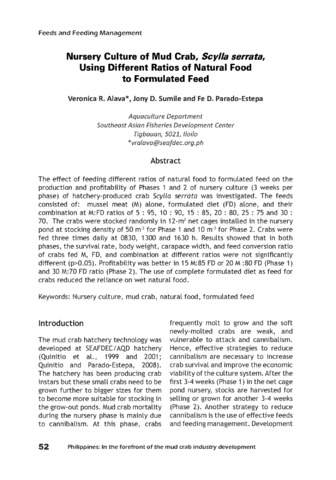| dc.contributor.author | Santiago, Corazon B | |
| dc.contributor.author | Aldaba, Mercedes B. | |
| dc.contributor.author | Reyes, Ofelia S. | |
| dc.date.accessioned | 2013-01-10T09:13:41Z | |
| dc.date.available | 2013-01-10T09:13:41Z | |
| dc.date.issued | 1987 | |
| dc.identifier.citation | Santiago, C. B., Aldaba, M. B., & Reyes, O. S. (1987). Influence of feeding rate and diet form on growth and survival of Nile tilapia (Oreochromis niloticus) fry. Aquaculture, 64(4), 277-282. | en |
| dc.identifier.issn | 0044-8486 | |
| dc.identifier.uri | http://hdl.handle.net/10862/1280 | |
| dc.description | Contribution No. 214 of the SEAFDEC Aquaculture Department. | en |
| dc.description.abstract | Young Nile tilapia (12 mg mean body weight and 11 mm total length) were stocked at a density of 5 fish/l in twelve 50-l aquaria filled with 30 l of tap water. They were fed pellet crumbles containing 35% crude protein at various daily feeding rates expressed as percentages of fish biomass. Mean increases in body weight after 5 weeks were 63, 198, 232 and 228 mg for the 15, 30, 45 and 60% feeding rates, respectively, when ambient temperature ranged from 19 to 21°C. Corresponding survival rates were 53, 85, 87 and 84%. Growth and survival rates were enhanced significantly (P < 0.01) at the 30, 45 and 60% feeding rates.
Two feeding trials were conducted to compare the growth and survival of fry fed pellet crumbles and an unpelleted form of the same diet. Results showed that growth and feed conversion were similar for both forms of diet. However, the survival rate of fry fed pellet crumbles was significantly higher (P < 0.01) than the survival rate of fry fed the unpelleted diet. Prior pelleting of the formulated diet for the tilapia fry given at 30% to 45% of fish biomass daily ensured high survival, fast growth and efficient feed conversion. | en |
| dc.language.iso | en | en |
| dc.publisher | Elsevier | en |
| dc.subject | Oreochromis niloticus | en |
| dc.title | Influence of feeding rate and diet form on growth and survival of Nile tilapia (Oreochromis niloticus) fry | en |
| dc.type | Article | en |
| dc.citation.volume | 64 | |
| dc.citation.issue | 4 | |
| dc.citation.spage | 277 | |
| dc.citation.epage | 282 | |
| dc.citation.journalTitle | Aquaculture | en |
| dc.subject.asfa | artificial feeding | en |
| dc.subject.asfa | feeding experiments | en |
| dc.subject.asfa | fish culture | en |
| dc.subject.asfa | food availability | en |
| dc.subject.asfa | feed conversion efficiency | en |
| dc.subject.asfa | growth | en |
| dc.subject.asfa | pelleted feeds | en |
| dc.subject.asfa | proteins | en |
| dc.subject.asfa | stocking density | en |
| dc.subject.asfa | survival | en |
| dc.identifier.doi | 10.1016/0044-8486(87)90190-6 | |



